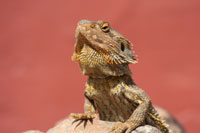Always be sure your reptiles get the lights they need.
|
Click image to enlarge  Basking reptiles, such as many of the most popular lizards and turtles, are prone to health problems if they don’t receive adequate quantities of UVB lighting. Basking reptiles, such as many of the most popular lizards and turtles, are prone to health problems if they don’t receive adequate quantities of UVB lighting.
|
As reptile owners may know, there are many reptile species that require full-spectrum lighting in order to thrive. Such lighting enables reptiles (and other animals) to metabolize vitamin D3, which aids in calcium absorption. Basking reptiles, such as many of the most popular lizards and turtles, are especially prone to health problems if they don’t receive adequate quantities of UVB lighting. Click here to read a great article on lighting>>
Luckily for reptile hobbyists there are lights available that provide the proper levels. I can’t begin to describe how these lights have done so much to aid people in prolonging the lives of their pet reptiles. I shudder to think how many herps met early deaths in the days before full-spectrum lights were common. Now you can choose from several types from some of the top reptile product manufacturers today, such as Zoo Med, Exo Terra, Zilla and Fluker’s.
If you don’t provide the right kind of lighting expect your reptiles to get sick. The most common ailment to affect reptiles that aren’t getting the right type of lighting is nutritional secondary hyperparathyroidism (also known as metabolic bone disease). What happens to such reptiles is that because they can’t process dietary calcium due to a lack of exposure to the proper lighting, their bodies start to absorb the calcium from their bones. This can lead to deformities, such as twisted limbs and “rubber jaw,” and even death if it’s allowed to continue.
Full-spectrum lighting is readily available and there is no good reason why your reptiles that need it shouldn’t have access to it. One thing to remember, however: The UVB-giving properties of these lights will diminish over time, even though the light will still remain lit. If you wait for the light to burn out completely you will be denying your reptiles their UVB quota for some time. So when you’re buying full-spectrum lights always be sure to read the manufacturers instructions on the product, as they should include recommendations as to when you should replace the light. I know it may seem weird to replace a light that is still lighting up, but do what the manufacturers recommends. Your reptiles will remain healthy because of it.
Then there’s heat. Some lights are needed for UVB, others are needed to provide heat to reptiles. This is another ultra-critical aspect of proper reptile maintenance. Reptiles need heat in order to digest their food properly. Obviously, if they can’t do that they will not remain healthy for long.
Ideally, what you want is full-spectrum lighting over the entire enclosure, and a heat lamp focused on a specific rock or branch as a basking spot. This basking spot should be the hottest area in the enclosure. Typically it is located at one end of the enclosure. Placing it at one end allows the reptiles inside to thermoregulate. This means they will move from the warmer end of the enclosure to the cooler end, positioning themselves wherever they feel most comfortable or need the most heat at any given time. It’s not unusual, for instance, for a lizard that has just devoured a bunch of crickets to stay in the hot basking spot. They’ll also commonly head for the basking area right when the lights are turned on in the morning. When they feel cool in the morning they’ll head for the hot area to warm up.
There are some other things to remember about your reptile lights. To achieve maximum efficiency, full-spectrum lights should be placed a specific distance from the animal. Again, check the manufacturers’ directions on the packaging, but a distance of about 10 inches is pretty common, I think. Also, UVB rays will not pass through glass, so full-spectrum lighting must be used over either open-topped or screened enclosures in order to work properly.
Heat lights should be positioned so that your reptiles cannot come into contact with them. I’ve seen some pretty nasty photos of reptiles that have been burned, and you don’t want that. Be extra careful with snakes; you definitely do not want your snake to be able to coil around a hot light fixture.
Speaking of snakes, opinions vary as to whether or not they need full-spectrum lighting. The theory is they absorb sufficient levels of calcium from the bones of their prey. My personal feeling is it’s better to be safe than sorry. If you are keeping a snake that in the wild would be exposed to sunlight, then you should provide full-spectrum lighting.
There is also debate as to whether nocturnal lizards, such as some geckos, need full-spectrum lights. This may fall under the better safe than sorry column, too. I provided it to my leopard geckos and it never seemed to cause them any harm. And at the same time I felt I had my bases covered, just in case. Again, if you can afford the lights, why not use them?
There are fluorescent tubes, incandescent spot lights, mercury vapor bulbs, compact fluorescents…many types are available. Check them out and make the right choice. You may need to combine a couple of different types to give your reptiles exactly what they need.


